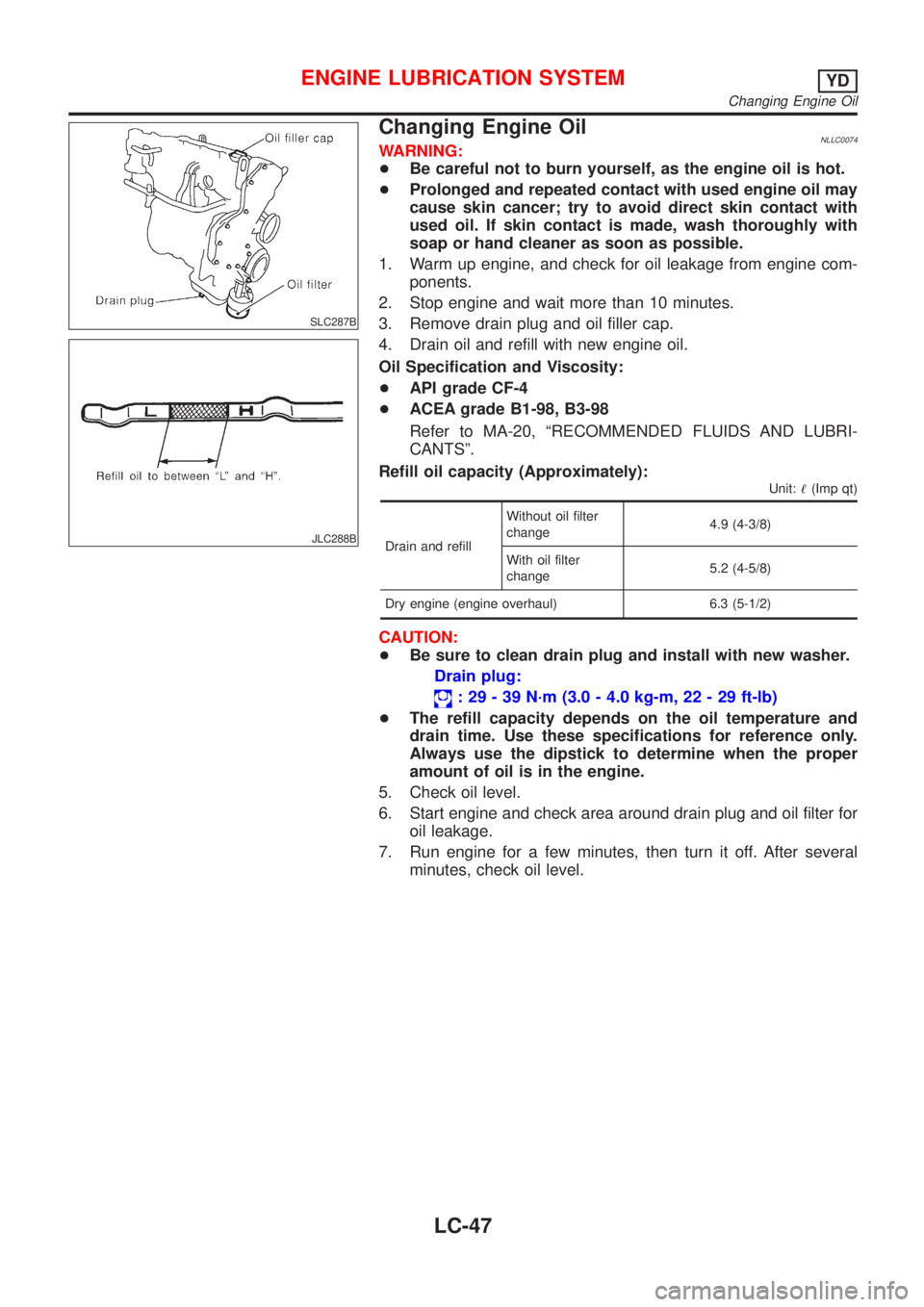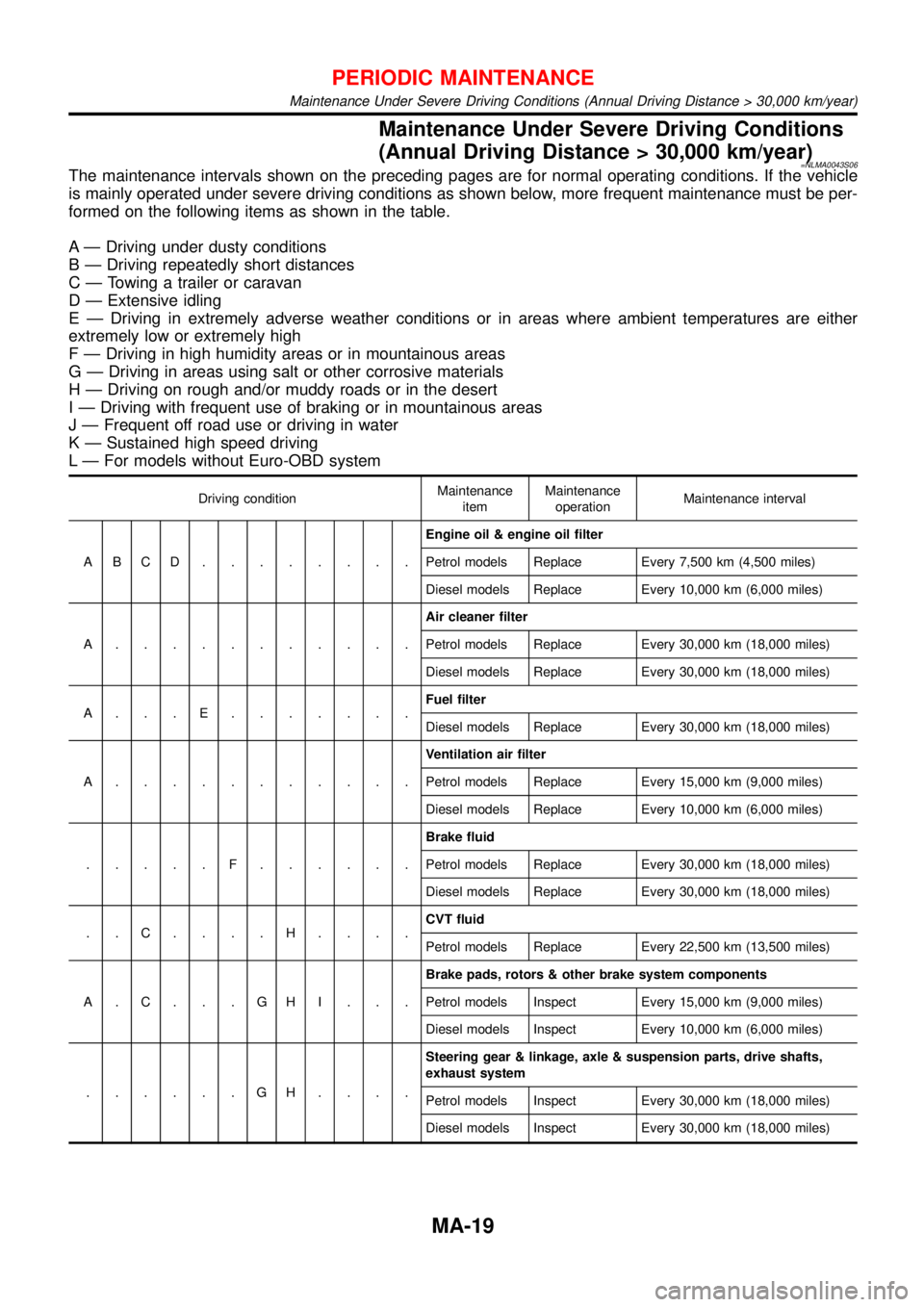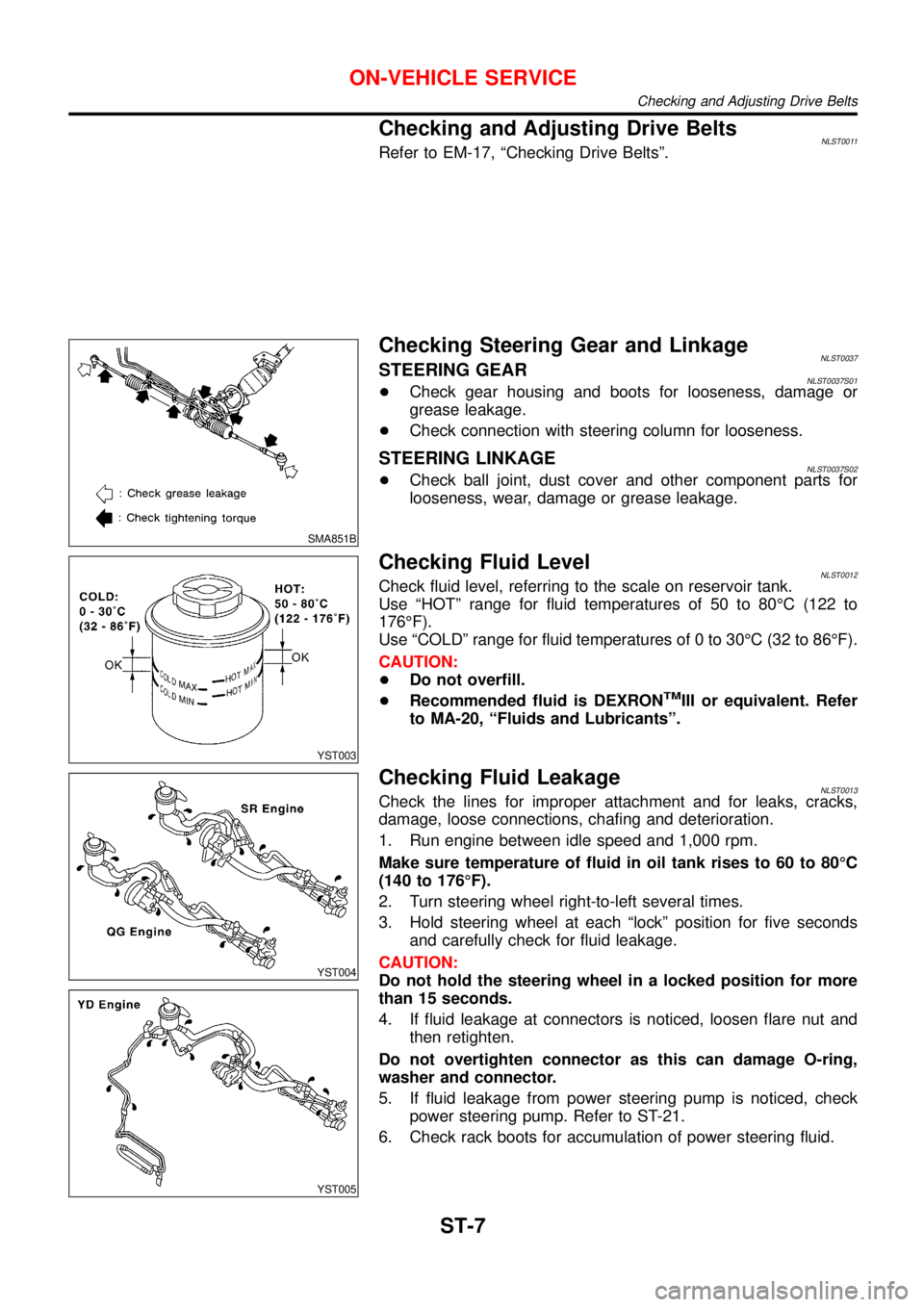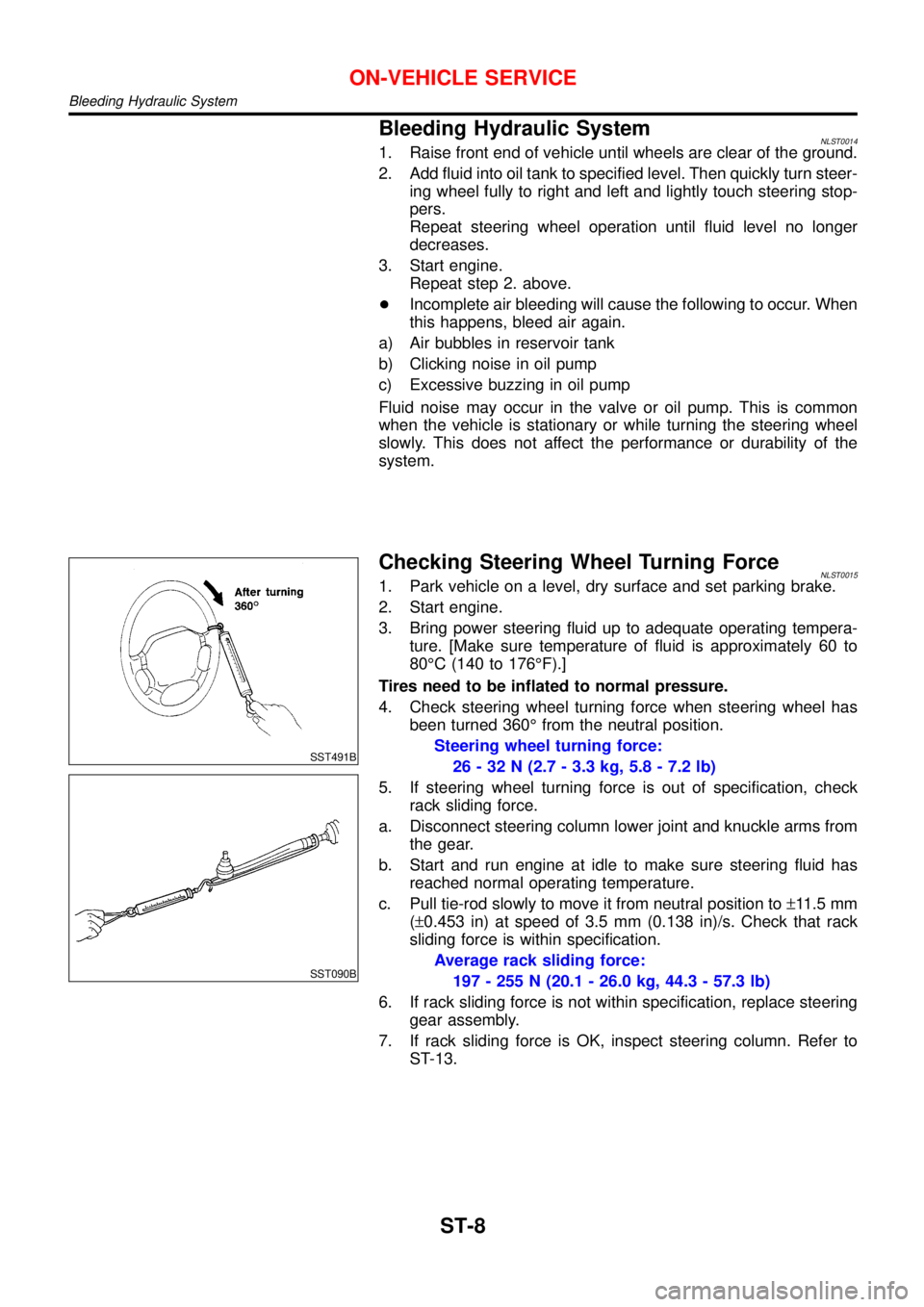2001 NISSAN ALMERA TINO oil temperature
[x] Cancel search: oil temperaturePage 2747 of 3051

SLC283B
JLC284B
SLC926-A
Oil Pressure CheckNLLC0042WARNING:
+Be careful not to burn yourself, as the engine and oil may
be hot.
+Oil pressure check should be done in ªNeutral positionº.
1. Check oil level.
2. Remove exhaust front tube.
3. Remove oil pressure switch.
4. Install pressure gauge.
5. Install exhaust front tube.
6. Start engine and warm it up to normal operating temperature.
7. Check oil pressure with engine running under no-load.
Engine speed
rpmApproximate discharge pressure
kPa (bar, kg/cm2, psi)
Idle speed More than 140 (1.40, 1.43, 20.3)
2,000 More than 270 (2.69, 2.75, 39.1)
4,000 More than 430 (4.29, 4.38, 62.3)
If difference is extreme, check oil passage and oil pump
for oil leaks.
8. After the inspections, install the oil pressure switch as follows.
a. Remove the old sealant adhering to the switch and engine.
b. Apply Genuine Liquid Gasket or equivalent to the thread and
tighten.
: 13 - 17 N´m (1.25 - 1.75 kg-m,9-12ft-lb)
Oil Pump
REMOVAL AND INSTALLATIONNLLC0043+When installing oil pump, apply engine oil to rotors.
Refer to EM-181, ªPrimary Timing Chainº for removal.
Reinstall all parts in the reverse order of removal.
ENGINE LUBRICATION SYSTEMYD
Lubrication Circuit (Cont'd)
LC-44
Page 2750 of 3051

SLC287B
JLC288B
Changing Engine OilNLLC0074WARNING:
+Be careful not to burn yourself, as the engine oil is hot.
+Prolonged and repeated contact with used engine oil may
cause skin cancer; try to avoid direct skin contact with
used oil. If skin contact is made, wash thoroughly with
soap or hand cleaner as soon as possible.
1. Warm up engine, and check for oil leakage from engine com-
ponents.
2. Stop engine and wait more than 10 minutes.
3. Remove drain plug and oil filler cap.
4. Drain oil and refill with new engine oil.
Oil Specification and Viscosity:
+API grade CF-4
+ACEA grade B1-98, B3-98
Refer to MA-20, ªRECOMMENDED FLUIDS AND LUBRI-
CANTSº.
Refill oil capacity (Approximately):
Unit:!(Imp qt)
Drain and refillWithout oil filter
change4.9 (4-3/8)
With oil filter
change5.2 (4-5/8)
Dry engine (engine overhaul) 6.3 (5-1/2)
CAUTION:
+Be sure to clean drain plug and install with new washer.
Drain plug:
: 29 - 39 N´m (3.0 - 4.0 kg-m, 22 - 29 ft-lb)
+The refill capacity depends on the oil temperature and
drain time. Use these specifications for reference only.
Always use the dipstick to determine when the proper
amount of oil is in the engine.
5. Check oil level.
6. Start engine and check area around drain plug and oil filter for
oil leakage.
7. Run engine for a few minutes, then turn it off. After several
minutes, check oil level.
ENGINE LUBRICATION SYSTEMYD
Changing Engine Oil
LC-47
Page 2775 of 3051

Maintenance Under Severe Driving Conditions=NLMA0046S04The maintenance intervals shown on the preceding pages are for normal operating conditions. If the vehicle
is mainly operated under severe driving conditions as shown below, more frequent maintenance must be per-
formed on the following items as shown in the table.
SEVERE DRIVING CONDITIONSNLMA0046S0401A—Driving under dusty conditions
B—Driving repeatedly short distances
C—Towing a trailer or caravan
D—Extensive idling
E—Driving in extremely adverse weather conditions or in areas where ambient temperatures are either
extremely low or extremely high
F—Driving in high humidity areas or in mountainous areas
G—Driving in areas using salt or other corrosive materials
H—Driving on rough and/or muddy roads or in the desert
I—Driving with frequent use of braking or in mountainous areas
Driving condition Maintenance itemMaintenance
operationMaintenance
intervalRefer-
ence
page
A........Aircleaner filter Viscous paper type Replace More frequentlyEM-18,
EM-88,
EM-169
ABCD.....Engine oil & oil filter (QG18DE/SR20DE
engine)ReplaceEvery 5,000 km
(3,000 miles) or 3
monthsLC-8,
LC-28,
LC-9,
LC-28
ABCD.....Engine oil (YD22DDTi engine)
ReplaceMore frequently LC-47
Engine oil filter (YD22DDTi engine)Every 7,500 km
(4,500 miles) or 6
monthsLC-48
A...E....Fuel filter (YD22DDTi engine) ReplaceEvery 20,000 km
(12,000 miles) or
12 monthsFE-15
.....F...Brake fluid ReplaceEvery 20,000 km
(12,000 miles) or
12 monthsBR-7
..C....H.H·CVT fluid ReplaceEvery 20,000 km
(12,000 miles) or
12 monthsAT-11
......GH.Steering gear & linkage, axle & suspen-
sion parts & drive shaftsCheckEvery 10,000 km
(6,000 miles) or 6
monthsST-7,
SU-5,
SU-18
A.C...GHIBrake pads, rotors & other brake com-
ponentsCheckEvery 5,000 km
(3,000 miles) or 3
monthsBR-24,
BR-28
......G..Lock, hinges & hood latch LubricateEvery 5,000 km
(3,000 miles) or 3
monthsBT-7,
BT-13
A........Ventilation air filter Replace More frequently HA-103
PERIODIC MAINTENANCE (EXCEPT FOR EUROPE)
Maintenance Under Severe Driving Conditions
MA-8
Page 2780 of 3051

Maintenance Under Severe Driving Conditions
(Annual Driving Distance < 30,000 km/year)
=NLMA0043S03The maintenance intervals shown on the preceding pages are for normal operating conditions. If the vehicle
is mainly operated under severe driving conditions as shown below, more frequent maintenance must be per-
formed on the following items as shown in the table.
A—Driving under dusty conditions
B—Driving repeatedly short distances
C—Towing a trailer or caravan
D—Extensive idling
E—Driving in extremely adverse weather conditions or in areas where ambient temperatures are either
extremely low or extremely high
F—Driving in high humidity areas or in mountainous areas
G—Driving in areas using salt or other corrosive materials
H—Driving on rough and/or muddy roads or in the desert
I—Driving with frequent use of braking or in mountainous areas
J—Frequent off road use or driving in water
K—Sustained high speed driving
L—For models without Euro-OBD system
Driving conditionMaintenance
itemMaintenance
operationMaintenance interval
ABCD........Engine oil & engine oil filter
Petrol models ReplaceEvery 7,500 km (4,500 miles) or 6
months
Diesel models ReplaceEvery 10,000 km (6,000 miles) or
6 months
A...........Air cleaner filter
Petrol models ReplaceEvery 30,000 km (18,000 miles) or
24 months
Diesel models ReplaceEvery 30,000 km (18,000 miles) or
18 months
A...E.......Fuel filter
Diesel models ReplaceEvery 20,000 km (12,000 miles) or
12 months
A...........Ventilation air filter
Petrol models ReplaceEvery 15,000 km (9,000 miles) or
12 months
Diesel models ReplaceEvery 10,000 km (6,000 miles) or
6 months
.....F......Brake fluid
Petrol models ReplaceEvery 15,000 km (9,000 miles) or
12 months
Diesel models ReplaceEvery 20,000 km (12,000 miles) or
12 months
A.C...GHI...Brake pads, rotors & other brake system components
Petrol models InspectEvery 7,500 km (4,500 miles) or 6
months
Diesel models InspectEvery 10,000 km (6,000 miles) or
6 months
PERIODIC MAINTENANCE
Maintenance Under Severe Driving Conditions (Annual Driving Distance < 30,000 km/year)
MA-13
Page 2786 of 3051

Maintenance Under Severe Driving Conditions
(Annual Driving Distance > 30,000 km/year)
=NLMA0043S06The maintenance intervals shown on the preceding pages are for normal operating conditions. If the vehicle
is mainly operated under severe driving conditions as shown below, more frequent maintenance must be per-
formed on the following items as shown in the table.
A—Driving under dusty conditions
B—Driving repeatedly short distances
C—Towing a trailer or caravan
D—Extensive idling
E—Driving in extremely adverse weather conditions or in areas where ambient temperatures are either
extremely low or extremely high
F—Driving in high humidity areas or in mountainous areas
G—Driving in areas using salt or other corrosive materials
H—Driving on rough and/or muddy roads or in the desert
I—Driving with frequent use of braking or in mountainous areas
J—Frequent off road use or driving in water
K—Sustained high speed driving
L—For models without Euro-OBD system
Driving conditionMaintenance
itemMaintenance
operationMaintenance interval
ABCD........Engine oil & engine oil filter
Petrol models Replace Every 7,500 km (4,500 miles)
Diesel models Replace Every 10,000 km (6,000 miles)
A...........Air cleaner filter
Petrol models Replace Every 30,000 km (18,000 miles)
Diesel models Replace Every 30,000 km (18,000 miles)
A...E.......Fuel filter
Diesel models Replace Every 30,000 km (18,000 miles)
A...........Ventilation air filter
Petrol models Replace Every 15,000 km (9,000 miles)
Diesel models Replace Every 10,000 km (6,000 miles)
.....F......Brake fluid
Petrol models Replace Every 30,000 km (18,000 miles)
Diesel models Replace Every 30,000 km (18,000 miles)
..C....H....CVT fluid
Petrol models Replace Every 22,500 km (13,500 miles)
A.C...GHI...Brake pads, rotors & other brake system components
Petrol models Inspect Every 15,000 km (9,000 miles)
Diesel models Inspect Every 10,000 km (6,000 miles)
......GH....Steering gear & linkage, axle & suspension parts, drive shafts,
exhaust system
Petrol models Inspect Every 30,000 km (18,000 miles)
Diesel models Inspect Every 30,000 km (18,000 miles)
PERIODIC MAINTENANCE
Maintenance Under Severe Driving Conditions (Annual Driving Distance > 30,000 km/year)
MA-19
Page 2916 of 3051

SRS443
CAUTION:
+Always place driver air bag module with pad side facing
upward.
+Do not attempt to disassemble driver air bag module.
+The special bolts are coated with bonding agent. Do not
use old bolts after removal; replace with new ones.
+Do not insert any foreign objects (screwdriver, etc.) into
driver air bag module connector.
SBF814E
+Replace driver air bag module if it has been dropped or
sustained an impact.
+Do not expose the driver air bag module to temperatures
exceeding 90°C (194°F).
+Do not allow oil, grease or water to come in contact with
the driver air bag module.
SBF239F
3. Set steering wheel in the neutral position.
4. Disconnect horn connector (or horn/audio connector) and
remove nut.
5. Using steering wheel puller, remove steering wheel. Be care-
ful not to over-tighten puller bolt on steering wheel.
CAUTION:
+Do not tap or bump the steering wheel.
6. Remove steering column cover.
NRS105
7. Remove the inner steering cover.
SRS384
8. Remove four spiral cable securing screws, and extract spiral
cable forward. Unlock spiral cable connector, then remove spi-
ral cable.
CAUTION:
+Do not attempt to disassemble spiral cable.
+Do not apply lubricant to the spiral cable.
SUPPLEMENTAL RESTRAINT SYSTEM (SRS)
Driver Air Bag Module and Spiral Cable (Cont’d)
RS-25
Page 3002 of 3051

Checking and Adjusting Drive BeltsNLST0011Refer to EM-17,“Checking Drive Belts”.
SMA851B
Checking Steering Gear and LinkageNLST0037STEERING GEARNLST0037S01+Check gear housing and boots for looseness, damage or
grease leakage.
+Check connection with steering column for looseness.
STEERING LINKAGENLST0037S02+Check ball joint, dust cover and other component parts for
looseness, wear, damage or grease leakage.
YST003
Checking Fluid LevelNLST0012Check fluid level, referring to the scale on reservoir tank.
Use“HOT”range for fluid temperatures of 50 to 80°C (122 to
176°F).
Use“COLD”range for fluid temperatures of 0 to 30°C (32 to 86°F).
CAUTION:
+Do not overfill.
+Recommended fluid is DEXRON
TMIII or equivalent. Refer
to MA-20,“Fluids and Lubricants”.
YST004
YST005
Checking Fluid LeakageNLST0013Check the lines for improper attachment and for leaks, cracks,
damage, loose connections, chafing and deterioration.
1. Run engine between idle speed and 1,000 rpm.
Make sure temperature of fluid in oil tank rises to 60 to 80°C
(140 to 176°F).
2. Turn steering wheel right-to-left several times.
3. Hold steering wheel at each“lock”position for five seconds
and carefully check for fluid leakage.
CAUTION:
Do not hold the steering wheel in a locked position for more
than 15 seconds.
4. If fluid leakage at connectors is noticed, loosen flare nut and
then retighten.
Do not overtighten connector as this can damage O-ring,
washer and connector.
5. If fluid leakage from power steering pump is noticed, check
power steering pump. Refer to ST-21.
6. Check rack boots for accumulation of power steering fluid.
ON-VEHICLE SERVICE
Checking and Adjusting Drive Belts
ST-7
Page 3003 of 3051

Bleeding Hydraulic SystemNLST00141. Raise front end of vehicle until wheels are clear of the ground.
2. Add fluid into oil tank to specified level. Then quickly turn steer-
ing wheel fully to right and left and lightly touch steering stop-
pers.
Repeat steering wheel operation until fluid level no longer
decreases.
3. Start engine.
Repeat step 2. above.
+Incomplete air bleeding will cause the following to occur. When
this happens, bleed air again.
a) Air bubbles in reservoir tank
b) Clicking noise in oil pump
c) Excessive buzzing in oil pump
Fluid noise may occur in the valve or oil pump. This is common
when the vehicle is stationary or while turning the steering wheel
slowly. This does not affect the performance or durability of the
system.
SST491B
SST090B
Checking Steering Wheel Turning ForceNLST00151. Park vehicle on a level, dry surface and set parking brake.
2. Start engine.
3. Bring power steering fluid up to adequate operating tempera-
ture. [Make sure temperature of fluid is approximately 60 to
80°C (140 to 176°F).]
Tires need to be inflated to normal pressure.
4. Check steering wheel turning force when steering wheel has
been turned 360°from the neutral position.
Steering wheel turning force:
26 - 32 N (2.7 - 3.3 kg, 5.8 - 7.2 lb)
5. If steering wheel turning force is out of specification, check
rack sliding force.
a. Disconnect steering column lower joint and knuckle arms from
the gear.
b. Start and run engine at idle to make sure steering fluid has
reached normal operating temperature.
c. Pull tie-rod slowly to move it from neutral position to±11.5 mm
(±0.453 in) at speed of 3.5 mm (0.138 in)/s. Check that rack
sliding force is within specification.
Average rack sliding force:
197 - 255 N (20.1 - 26.0 kg, 44.3 - 57.3 lb)
6. If rack sliding force is not within specification, replace steering
gear assembly.
7. If rack sliding force is OK, inspect steering column. Refer to
ST-13.
ON-VEHICLE SERVICE
Bleeding Hydraulic System
ST-8